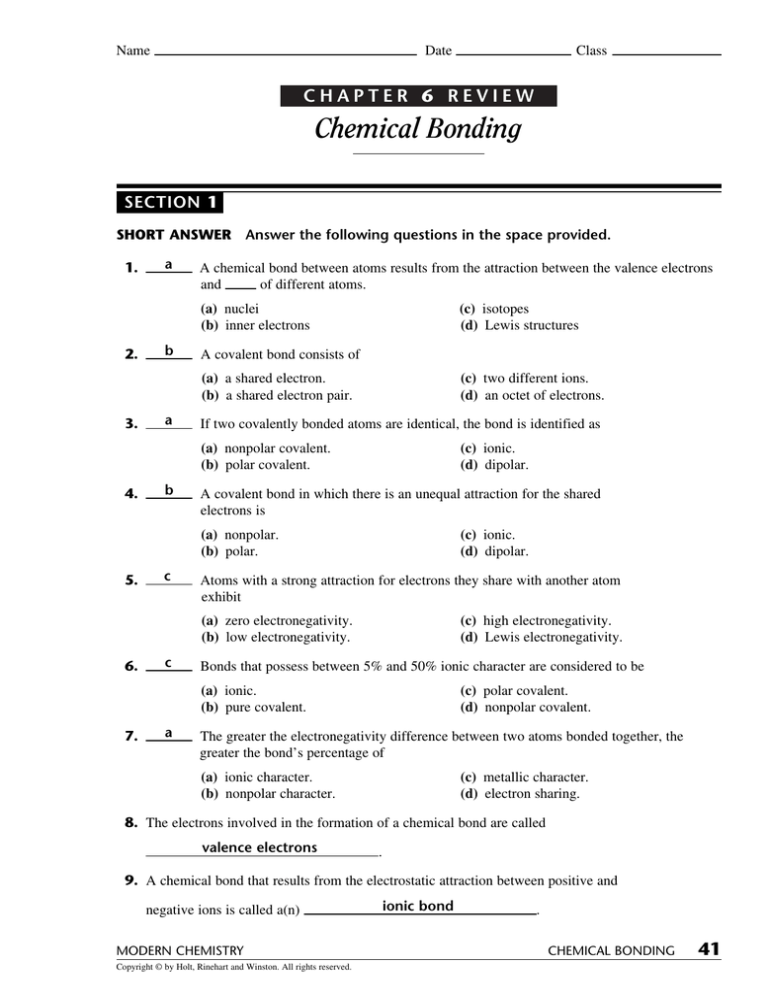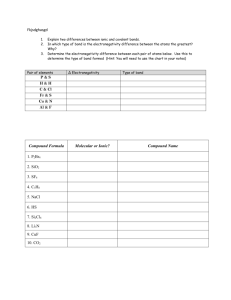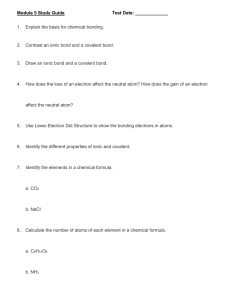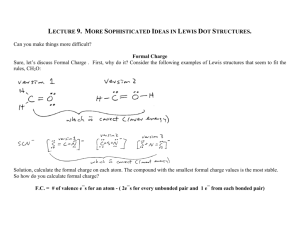
Name
Date
Class
CHAPTER 6 REVIEW
Chemical Bonding
SECTION 1
SHORT ANSWER
1.
a
Answer the following questions in the space provided.
A chemical bond between atoms results from the attraction between the valence electrons
and
of different atoms.
(a) nuclei
(b) inner electrons
2.
b
(c) isotopes
(d) Lewis structures
A covalent bond consists of
(a) a shared electron.
(b) a shared electron pair.
3.
a
(c) two different ions.
(d) an octet of electrons.
If two covalently bonded atoms are identical, the bond is identified as
(a) nonpolar covalent.
(b) polar covalent.
4.
b
(c) ionic.
(d) dipolar.
A covalent bond in which there is an unequal attraction for the shared
electrons is
(a) nonpolar.
(b) polar.
5.
c
(c) ionic.
(d) dipolar.
Atoms with a strong attraction for electrons they share with another atom
exhibit
(a) zero electronegativity.
(b) low electronegativity.
6.
c
(c) high electronegativity.
(d) Lewis electronegativity.
Bonds that possess between 5% and 50% ionic character are considered to be
(a) ionic.
(b) pure covalent.
7.
a
(c) polar covalent.
(d) nonpolar covalent.
The greater the electronegativity difference between two atoms bonded together, the
greater the bond’s percentage of
(a) ionic character.
(b) nonpolar character.
(c) metallic character.
(d) electron sharing.
8. The electrons involved in the formation of a chemical bond are called
valence electrons
.
9. A chemical bond that results from the electrostatic attraction between positive and
negative ions is called a(n)
MODERN CHEMISTRY
Copyright © by Holt, Rinehart and Winston. All rights reserved.
ionic bond
.
CHEMICAL BONDING
41
Name
Date
Class
SECTION 1 continued
10. If electrons involved in bonding spend most of the time closer to one atom rather than
polar covalent
the other, the bond is
.
11. If a bond’s character is more than 50% ionic, then the bond is called
ionic bond
a(n)
.
12. A bond’s character is more than 50% ionic if the electronegativity difference between the two
atoms is greater than
1.7
.
13. Write the formula for an example of each of the following compounds:
Answers will vary.
H2
a. nonpolar covalent compound
HCl
b. polar covalent compound
NaCl
c. ionic compound
14. Describe how a covalent bond holds two atoms together.
A pair of electrons is attracted to both nuclei of the two atoms bonded together.
15. What property of the two atoms in a covalent bond determines whether or not the bond will be
polar?
electronegativity
16. How can electronegativity be used to distinguish between an ionic bond and a covalent bond?
The difference between the electronegativity of the two atoms in a bond will
determine whether the bond is ionic or covalent. If the difference in
electronegativity is greater than 1.7, the bond is considered ionic.
17. Describe the electron distribution in a polar-covalent bond and its effect on the partial charges of
the compound.
The electron density is greater around the more electronegative atom, giving that
part of the compound a partial negative charge. The other part of the compound
has an equal partial positive charge.
42
CHEMICAL BONDING
MODERN CHEMISTRY
Copyright © by Holt, Rinehart and Winston. All rights reserved.
Name
Date
Class
CHAPTER 6 REVIEW
Chemical Bonding
SECTION 2
SHORT ANSWER
Answer the following questions in the space provided.
1. Use the concept of potential energy to describe how a covalent bond forms between two atoms.
As the atoms involved in the formation of a covalent bond approach each other, the
electron-proton attraction is stronger than the electron-electron and proton-proton
repulsions. The atoms are drawn to each other and their potential energy decreases.
Eventually, a distance is reached at which the repulsions between the like charges
equals the attraction of the opposite charges. At this point, potential energy is at a
minimum and a stable molecule forms.
2. Name two elements that form compounds that can be exceptions to the octet rule.
Choose from hydrogen, boron, beryllium, phosphorus, sulfur, and xenon.
3. Explain why resonance structures are used instead of Lewis structures to correctly model certain
molecules.
Resonance structures show that one Lewis structure cannot correctly represent
the location of electrons in a bond. Resonance structures show delocalized
electrons, while Lewis structures depict electrons in a definite location.
4. Bond energy is related to bond length. Use the data in the tables below to arrange the bonds listed
in order of increasing bond length, from shortest bond to longest.
a.
Bond
Bond energy (kJ/mol)
H—F
569
H—I
299
H—Cl
432
H—Br
366
H—F, H—Cl, H—Br, H—I
MODERN CHEMISTRY
Copyright © by Holt, Rinehart and Winston. All rights reserved.
CHEMICAL BONDING
43
Name
Date
Class
SECTION 2 continued
b.
Bond
Bond energy (kJ/mol)
C—C
C—
—
—C
346
C—
—C
612
835
C—
— C, C— C, C—C
5. Draw Lewis structures to represent each of the following formulas:
O
a. NH3 FF
H ON OH
H
O
FF
b. H2O FF
H OO
H
c. CH4
O
H
O
H OCO H
H
d. C2H2
H OC 'COH
O
e. CH2O
H
a
HOC|O
44
CHEMICAL BONDING
MODERN CHEMISTRY
Copyright © by Holt, Rinehart and Winston. All rights reserved.
Name
Date
Class
CHAPTER 6 REVIEW
Chemical Bonding
SECTION 3
SHORT ANSWER
1.
a
Answer the following questions in the space provided.
The notation for sodium chloride, NaCl, stands for one
(a) formula unit.
(b) molecule.
2.
d
In a crystal of an ionic compound, each cation is surrounded by a number of
(a) molecules.
(b) positive ions.
3.
b
b
b
(c) equal in potential energy.
(d) unstable.
The lattice energy of compound A is greater in magnitude than that of compound B. What
can be concluded from this fact?
(a)
(b)
(c)
(d)
5.
(c) dipoles.
(d) negative ions.
Compared with the neutral atoms involved in the formation of an ionic compound, the
crystal lattice that results is
(a) higher in potential energy.
(b) lower in potential energy.
4.
(c) crystal.
(d) atom.
Compound A is not an ionic compound.
It will be more difficult to break the bonds in compound A than those in compound B.
Compound B has larger crystals than compound A.
Compound A has larger crystals than compound B.
The forces of attraction between molecules in a molecular compound are generally
(a)
(b)
(c)
(d)
stronger than the attractive forces among formula units in ionic bonding.
weaker than the attractive forces among formula units in ionic bonding.
approximately equal to the attractive forces among formula units in ionic bonding.
equal to zero.
6. Describe the force that holds two ions together in an ionic bond.
The force of attraction between unlike charges holds a negative ion and a positive
ion together in an ionic bond.
7. What type of energy best represents the strength of an ionic bond?
lattice energy
MODERN CHEMISTRY
Copyright © by Holt, Rinehart and Winston. All rights reserved.
CHEMICAL BONDING
45
Name
Date
Class
SECTION 3 continued
8. What types of bonds are present in an ionic compound that contains a polyatomic ion?
The atoms in a polyatomic ion are held together with covalent bonds, but
polyatomic ions combine with ions of opposite charge to form ionic compounds.
9. Arrange the ionic bonds in the table below in order of increasing strength from weakest to
strongest.
Ionic bond
Lattice energy (kJ/mol)
NaCl
787
CaO
3384
KCl
715
MgO
3760
LiCl
861
KCl, NaCl, LiCl, CaO, MgO
10. Draw Lewis structures for the following polyatomic ions:
a. NH4
[ ]
+
O
H
H ON OH
O
H
b. SO42
C O
[
COC
C C
C C
O C
CO OS O OC
COC
]
2–
aO
E
O
a
a
N
A
|
CHEMICAL BONDING
O
E
46
O
a
O
N
A
O
|
11. Draw the two resonance structures for the nitrite anion, NO
2.
MODERN CHEMISTRY
Copyright © by Holt, Rinehart and Winston. All rights reserved.
Name
Date
Class
CHAPTER 6 REVIEW
Chemical Bonding
SECTION 4
SHORT ANSWER
1.
b
Answer the following questions in the space provided.
In metals, the valence electrons are considered to be
(a) attached to particular positive ions.
(b) shared by all surrounding atoms.
2.
a
The fact that metals are malleable and ionic crystals are brittle is best
explained in terms of their
(a) chemical bonds.
(b) London forces.
3.
d
d
allow the light to pass through.
become attached to particular positive ions.
fall to lower energy levels.
absorb and re-emit the light.
Mobile electrons in the metallic bond are responsible for
(a) luster.
(b) thermal conductivity.
5.
a
In general, the strength of the metallic bond
right on any row of the periodic table.
(a) increases
(b) decreases
6.
c
(c) enthalpies of vaporization.
(d) polarity.
As light strikes the surface of a metal, the electrons in the electron sea
(a)
(b)
(c)
(d)
4.
(c) immobile.
(d) involved in covalent bonds.
(c) electrical conductivity.
(d) All of the above.
moving from left to
(c) remains the same
(d) varies
When a metal is drawn into a wire, the metallic bonds
(a) break easily.
(b) break with difficulty.
(c) do not break.
(d) become ionic bonds.
7. Use the concept of electron configurations to explain why the number of valence electrons in metals
tends to be less than the number in most nonmetals.
Most metals have their outer electrons in s orbitals, while nonmetals have their
outer electrons in p orbitals.
MODERN CHEMISTRY
Copyright © by Holt, Rinehart and Winston. All rights reserved.
CHEMICAL BONDING
47
Name
Date
Class
SECTION 4 continued
8. How does the behavior of electrons in metals contribute to the metal’s ability to conduct electricity
and heat?
The mobility of electrons in a network of metal atoms contributes to the
metal’s ability to conduct electricity and heat.
9. What is the relationship between the enthalpy of vaporization of a metal and the strength of the
bonds that hold the metal together?
The amount of energy required to vaporize a metal is a measure of the strength
of the bonds that hold the metal together. The greater a metal’s enthalpy of
vaporization, the stronger the metallic bond.
10. Draw two diagrams of a metallic bond. In the first diagram, draw a weak metallic bond; in the
second, show a metallic bond that would be stronger. Be sure to include nuclear charge and number
of electrons in your illustrations.
a.
b.
weak bond
strong bond
Note: In the strong bond, the charge on the nucleus and the number of electrons
must be greater than in the weak bond.
11. Complete the following table:
48
Metals
Ionic Compounds
Components
atoms
ions
Overall charge
neutral
neutral
Conductive in the solid state
yes
no
Melting point
low to high
high
Hardness
soft to hard
hard
Malleable
yes
no
Ductile
yes
no
CHEMICAL BONDING
MODERN CHEMISTRY
Copyright © by Holt, Rinehart and Winston. All rights reserved.
Name
Date
Class
CHAPTER 6 REVIEW
Chemical Bonding
SECTION 5
SHORT ANSWER
Answer the following questions in the space provided.
1. Identify the major assumption of the VSEPR theory, which is used to predict the shape of atoms.
Pairs of valence electrons repel one another.
2. In water, two hydrogen atoms are bonded to one oxygen atom. Why isn’t water a linear molecule?
The electron pairs that are not involved in bonding also take up space, creating
a tetrahedron of electron pairs and making the water molecule angular or bent.
3. What orbitals combine together to form sp3 hybrid orbitals around a carbon atom?
the s orbital and all three p orbitals from the second energy level
4. What two factors determine whether or not a molecule is polar?
electronegativity difference and molecular geometry or unshared electron pairs
5. Arrange the following types of attractions in order of increasing strength, with 1 being the weakest
and 4 the strongest.
3
hydrogen bonding
4
ionic
2
dipole-dipole
1
London dispersion
6. How are dipole-dipole attractions, London dispersion forces, and hydrogen bonding similar?
They are all forces of attraction between molecules. In all cases there is an attraction
between the slightly negatively-charged portion of one molecule and the slightly
positively charged portion of another molecule.
MODERN CHEMISTRY
Copyright © by Holt, Rinehart and Winston. All rights reserved.
CHEMICAL BONDING
49
Name
Date
Class
SECTION 5 continued
Lewis structure
Geometry
Polar
bent
yes
tetrahedral
no
trigonal planar
no
bent
yes
trigonal bipyramidal
no
Be—FC
linear
no
octahedral
no
CSC
H2S
—
—
H
H
— C
CCl4
C C
CClC
C C
Formula
C — — C
7. Complete the following table:
C —
CCl — C— ClC
CClC
FaC
B—
C —
CFa
—
BF3
CFC
C OC
H2O
—
—
H
CC — —— C
PCl5
H
CClC
P
—
—
a
CCl
aC
Cl
CCl
a
ClC
CF
SF6
CF
FC
CF—
S—
CF
CFC
CFC
C C
C
—
C
C— C
C C
BeF2
C
CHEMICAL BONDING
C
C C
—
50
MODERN CHEMISTRY
Copyright © by Holt, Rinehart and Winston. All rights reserved.
Name
Date
Class
CHAPTER 6 REVIEW
Chemical Bonding
MIXED REVIEW
SHORT ANSWER
Answer the following questions in the space provided.
1. Name the type of energy that is a measure of strength for each of the following types of bonds:
lattice energy
a. ionic bond
bond energy
b. covalent bond
enthalpy of vaporization
c. metallic bond
2. Use the electronegativity values shown in Figure 20, on page 161 of the text, to determine whether
each of the following bonds is nonpolar covalent, polar covalent, or ionic.
nonpolar covalent
d. H—H
b. Na—Cl
polar covalent
e. H—C
c. H—O
polar covalent
f. H—N
ionic
a. H—F
ionic
polar covalent
3. How is a hydrogen bond different from an ionic or covalent bond?
A hydrogen bond is a dipole-dipole attraction between a partially positive hydrogen
atom and the unshared electron pair of a strongly electronegative atom such as O,
N, or F. Unlike ionic or covalent bonds, in which electrons are given up or shared,
the hydrogen bond is a weaker attraction. Hydrogen bonds are generally
intermolecular, while ionic and covalent bonds occur between ions or atoms
respectively.
4. H2S and H2O have similar structures and their central atoms belong to the same group. Yet H2S is a
gas at room temperature and H2O is a liquid. Use bonding principles to explain why this is.
Oxygen has higher electronegativity than sulfur, which creates a highly polar bond.
Increased polarity in H2O bonds means a stronger intermolecular attraction, making
water a liquid at room temperature. Hydrogen bonding exists between water
molecules, but not between hydrogen sulfide molecules.
MODERN CHEMISTRY
Copyright © by Holt, Rinehart and Winston. All rights reserved.
CHEMICAL BONDING
51
Name
Date
Class
MIXED REVIEW continued
5. In what way is a polar-covalent bond similar to an ionic bond?
There is a difference between the electronegativities of the two atoms in both
types of bonds that results in electrons being more closely associated with the
more electronegative atom.
6. Draw a Lewis structure for each of the following formulas. Determine whether the molecule is
polar or nonpolar.
polar
a. H2S
polar
b. COCl2
CSC
—
—
H
C C
H
CCl
C C
—
C C
—
—
C —O
CCl
c. PCl3
C C
C — C
C C
polar
CCl —P — ClC
CClC
polar
d. CH2O
—
H
52
—
H
a
C—O
CHEMICAL BONDING
MODERN CHEMISTRY
Copyright © by Holt, Rinehart and Winston. All rights reserved.





